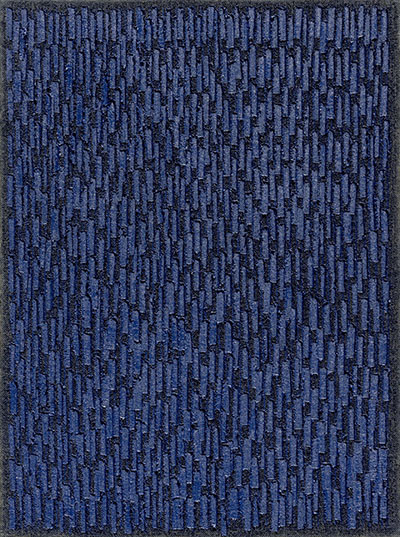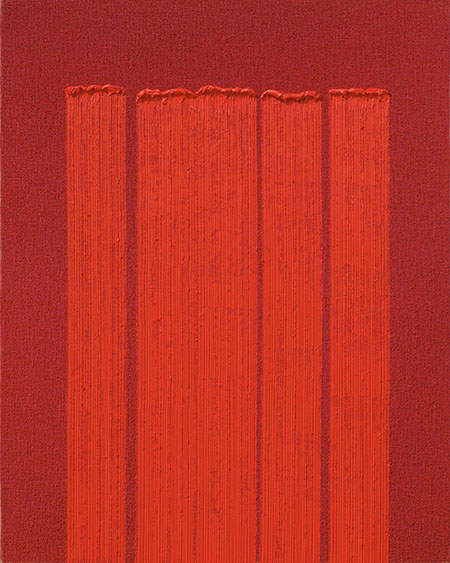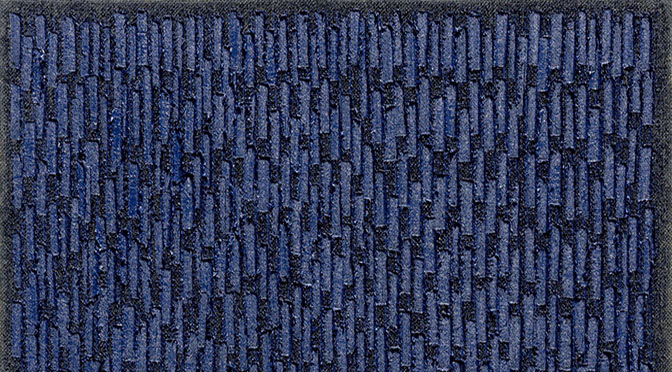
CARDI GALLERY MILAN
presenta
HA CHONG-HYUN
dal 18 settembre al 20 dicembre 2019
Opening
martedì 17 settembre, dalle 19 alle 21

Ha Chong-Hyun, Conjunction 18-12b (2018), oil on hemp cloth, courtesy Cardi Gallery, copyright The Artist
Cardi Gallery, Milano è lieta di presentare la mostra personale di Ha Chong-Hyun, uno degli artisti più apprezzati della Corea del Sud. Dal 18 settembre al 20 dicembre 2019, nella sede milanese della galleria saranno presentate opere della serie Conjunction, eseguite tra il 1972 e il 2019.
Ha Chong-Hyun è una delle personalità più importanti della storia dell’arte del dopoguerra, figura di spicco del movimento artistico coreano Dansaekhwa. Tra le privazioni materiali estreme e il sistema politico autoritario che hanno caratterizzato la Corea degli anni ’60 e ’70, l’artista ha esplorato il potenziale espressivo di materiali non convenzionali come carta da giornale, rottami di legno e filo spinato applicati sulla tela. Lavorando con le tonalità tenui della terra su superfici di tela e canapa, combinando tradizioni pittoriche orientali e occidentali e sfidando la delimitazione rigorosa tra scultura, pittura e performance, Ha Chong-Hyun ha contribuito a ridefinire il linguaggio della pittura.
Nel 1974 l’artista inizia a concentrarsi sulla materialità della pittura e a utilizzare la tela non solo come semplice supporto: nasce così la serie Conjunction, titolo che l’artista da quel momento dà a tutti i suoi dipinti e che descrive la filosofia da lui adottata, secondo cui la purezza del mezzo pittorico e la fisicità dell’artista si fondono, o sono congiunti, nell’atto del dipingere. In questi lavori Ha Chong-Hyun utilizza strumenti per spingere il colore a olio, monocromo, dal retro della tela grezza fino a farlo filtrare ed emergere attraverso la superficie. Successivamente, l’artista stende la vernice sul fronte della tela con il pennello o con la spatola, dando corpo a un’ampia varietà di composizioni astratte.
La mostra alla Cardi Gallery, Milano presenta una selezione di opere della serie Conjunction, sia storiche che più recenti, fino a un nucleo realizzato appositamente per l’occasione. Nei lavori esposti in galleria, la classica palette di colori neutri e blu profondi utilizzata da Ha Chong-Hyun si arricchisce di altre intense tonalità di blu, rosso e nero, il cui uso deriva dall’impegno dell’artista nell’esplorazione dei colori caratteristici degli interni coreani. Il rosso vermiglio, in particolare, rappresenta un elemento di novità, essendo entrato a far parte della pratica di Ha Chong-Hyun solo dal 2018.
Ha Chong-Hyun e gli artisti della sua generazione quali Lee Ufan, Park Seobo, Kwon Young-woo, Yun Hyong-keun e Chung Sang-hwa sono conosciuti come membri del movimento Dansaekhwa, termine che letteralmente significa “pittura monocromatica”, ma che definisce tanto le tecniche impiegate quanto l’estetica riduzionista a cui il gruppo fa riferimento. La stesura della vernice, le tele imbevute, le matite trascinate, la carta strappata e i materiali manipolati che caratterizzano l’approccio di questi artisti hanno cancellato e ridefinito i confini che fino a quel momento separavano il disegno a inchiostro dalla pittura a olio, la stessa pittura dalla scultura, e l’oggetto dallo spettatore.
Questa mostra offre l’opportunità di approfondire la conoscenza di un artista, ancora in attività, il cui lavoro ha sfidato la definizione tradizionale di pittura e ha contribuito ad aprire un nuovo e vitale capitolo dell’arte visiva coreana.
La mostra sarà accompagnata da un catalogo con un testo del critico d’arte Francesco Bonami.
Ha Chong-Hyun vive e lavora a Seul da quando si è laureato all’Università di Hongik nel 1959. Dal 1990 al 1994 è stato Decano del Fine Arts College dell’Università di Hongik ed è stato Direttore del Seoul Museum of Art dal 2001 al 2006.
È stato protagonista di importanti mostre personali all’Espace Paul Ricard di Parigi (1999), alla Fondazione Mudima di Milano (2003) e al Gyeongnam Art Museum di Changwon, Corea del Sud (2004). Ha rappresentato la Corea del Sud in importanti kermesse internazionali come la Biennale di Parigi nel 1961, la Biennale d’Arte di San Paolo nel 1967 e 1977, la Biennale di Venezia nel 1995 e la Biennale di Praga nel 2009. Tra le sue mostre più recenti ricordiamo la grande retrospettiva al Museo Nazionale di Arte Moderna e Contemporanea di Gwacheon, Corea, (2012), la mostra Dansaekhwa, evento collaterale della 56. Esposizione Internazionale d’Arte della Biennale di Venezia (2015), la mostra personale alla Kukje Gallery di Seoul (2015) e alla Tina Kim Gallery (2018).
Le opere di Ha Chong-Hyun sono conservate in collezioni pubbliche di importanti istituzioni come il Museum of Modern Art di New York, il Solomon R. Guggenheim Museum di New York, l’Art Institute of Chicago, il Museo M+ di Hong Kong, il Museo Nazionale d’Arte Moderna e Contemporanea, Corea, e il Leeum, Samsung Museum of Art di Seoul.
Cardi Gallery | Milano
Corso di Porta Nuova 38
20121 Milano Italy
T. (+39) 02.45478189
E. mail@cardigallery.com
www.cardigallery.com
@cardigallery
lunedì – venerdì 10.00-19.00
sabato su appuntamento
:::::::::::::::::::::::::::::::::::::::::::::
CARDI GALLERY
presents
HA CHONG-HYUN
From 18 September to 20 December 2019
Opening
Tuesday, 17 September, 7 – 9 pm
Cardi Gallery, Milan is pleased to present a solo exhibition of works by one of Korea’s most acclaimed artists Ha Chong-Hyun. On view from 18 September – 20 December 2019, the exhibition will feature mailny works from his Conjunction series from 1972 to 2019.
Ha Chong-hyun is one of the pioneering figures in the postwar art history and leading figure of Korea Dansaekhwa movement. Amid the extreme material deprivations and an authoritarian political system during the 1960s and 1970s, he explored the potential of unorthodox materials such as newsprint, scrap lumber, and barbed wire attached to canvas. Working with muted earth tones on burlap and hemp canvases while combining painting traditions from both the East and the West, Ha was instrumental in redefining the role of painting that challenged the strict delineation between sculpture, painting, and performance.
In 1974, he began to focus on the materiality of paint and burlap as more than a mere support through the Conjunction series, the name that the artist has given to all of his paintings since the early 1970s. It describes his philosophy wherein the purity of the painting medium and the artist’s physicality merge, or are conjoined, in the act of painting. In these works, he uses tools to push monochrome oil paint through the back of coarsely woven burlap so that it protrudes through the surface. Thereafter he brushes or smears the paint into a wide variety of abstract compositions.
The exhibition at Cardi Gallery, Milan presents new and recent works from the Conjunction series that use not only his signature palette of neutrals and navy, but also rich hues of blue, red and black. Ha’s use of red, blue, and vermillion shows the artist’s commitment to exploring colors seen in mundane surroundings in Korea. In particular, the vermillion color is new, that became part of Ha’s practice starting only last year.
Ha Chong-hyun and his peers came to be known as the Dansaekhwa movement, which includes artists such as Lee Ufan, Park Seobo, Kwon Young-woo, Yun Hyong-keun, and Chung Sang-hwa. Although the term literally means “monochrome painting,” it is defined by the methods employed as much as its reductionist aesthetics. The artists variously pushed paint, soaked canvas, dragged pencils, ripped paper, and otherwise manipulated materials in ways that troubled the distinctions separating ink painting from oil, painting from sculpture, and object from viewer.
This comprehensive exhibition at Cardi Gallery, Milan provides an invaluable opportunity to experience an artist whose work has challenged the traditional definition of painting and helped open a new and vital chapter in Korean abstract art. Still active in his eighties, the show will include both historical works as well as paintings made specifically for the exhibition.
Accompanying the exhibition is a book on the artist with an essay by art critic Francesco Bonami.
Ha Chong-Hyun has lived and worked in Seoul since graduating from Hongik University in 1959. From 1990 to 1994, he served as the Dean of the Fine Arts College at Hongik University and as the Director of the Seoul Museum of Art from 2001 to 2006.
Ha has had major solo exhibitions at Espace Paul Ricard, Paris (1999); Mudima Foundation of Contemporary, Milan (2003); and Gyeongnam Art Museum, Changwon, South Korea (2004). In addition, he represented South Korea in major international art exhibitions such as Paris Biennale in 1961; São Paolo Art Biennale in 1967 and 1977; Venice Biennale in 1995; and Prague Biennale in 2009. Recent exhibitions include a major retrospective at the National Museum of Modern and Contemporary Art, Korea, Gwacheon (2012), Dansaekhwa Collateral Event of the 56th International Art Exhibition-La Biennale di Venezia (2015), a solo exhibition at Kukje Gallery, Seoul (2015) and at Tina Kim Gallery (2018).
Ha Chong-Hyun works are held in public collections of prominent institutions, such as Museum of Modern Art, New York; The Solomon R. Guggenheim Museum, New York; Art Institute of Chicago; M+ Museum, Hong Kong; National Museum of Modern and Contemporary Art, Korea; and Leeum, Samsung Museum of Art, Seoul.
Foto copertina – particolare di Ha Chong-Hyun, Conjunction 17-54 (2017), oil on hemp cloth, courtesy of Cardi Gallery, copyright The Artist
